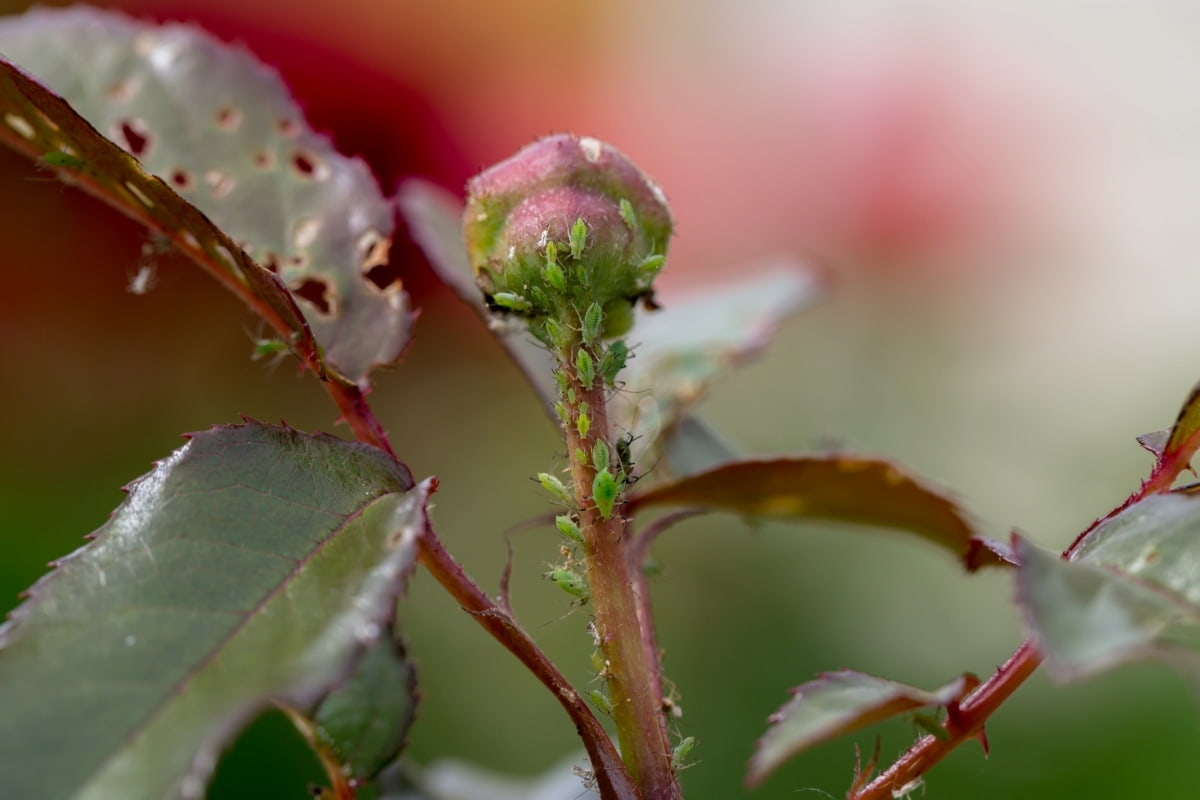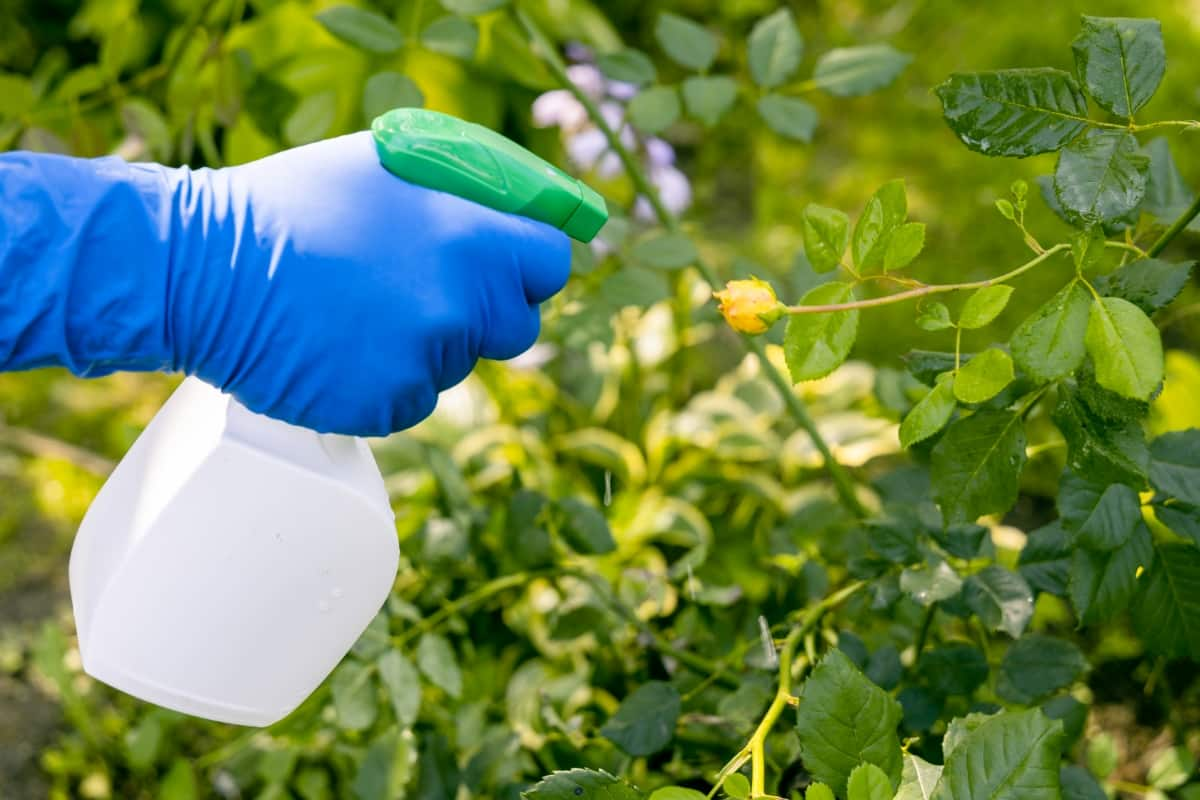Roses are beautiful flowers that can add a touch of elegance to any garden. However, they are also susceptible to many pests that can damage the plants and make them unsightly. This blog post will discuss 10 of the most common rose pests, including their symptoms, best treatments, prevention, and management.

Common Rose Plant Damaging Pests
Importance of Identifying and Managing Pests in Rose Plants
- Identify the pest: The first step is identifying the pest infesting your rose plant. Choose the most effective control method.
- Inspect your plants regularly: Inspect your rose plants regularly for signs of pests. This will help you to catch an infestation early when it is easier to control.
- Remove pests by hand: If the infestation is small, you can remove the pests by hand.
- Use natural controls: There are a number of natural controls that you can use to manage pests on rose plants. These include companion planting, insecticidal soap, and neem oil.
- Apply pesticides as a last resort: If natural controls are not effective, you may need to apply pesticides. Be sure to use pesticides only as a last resort, and follow the label directions carefully.
Aphids Damage on Rose Plant
Symptoms of Damage
- Curl, wilt, and yellow leaves
- Sticky honeydew
- Sooty mold
- Weakened plants
- Transmit diseases
How to Identify
- Small, soft-bodied insects
- Green, pink, or black
- Found on leaves, stems, and flowers
- Can produce large numbers quickly
How to Prevent
- Inspect plants regularly
- Remove aphids by hand
- Plant resistant varieties
- Avoid overhead watering
- Keep plants healthy
How to Treat
- Water plants with a strong stream of water
- Use insecticidal soap
- Neem oil
- Pesticides
Control and Management
- Cultural controls: Inspect plants regularly and remove aphids by hand. Plant resistant varieties and avoid overhead watering. Keep plants healthy by fertilizing and watering properly.
- Chemical controls: Use insecticidal soap, neem oil, or pesticides as a last option.
- Natural controls: Encourage natural predators such as ladybugs and lacewings.
Caterpillars Damage on Rose Plant
Symptoms of Damage
- Leaves eaten
- Holes in leaves
- Wilting leaves
- Stunted growth
- Dead leaves
How to Identify
- Small, furry insects
- Varied colors, depending on the species
- Found on leaves, stems, and flowers
How to Prevent
- Plant resistant varieties
- Inspect plants regularly
- Remove caterpillars by hand
- Use row covers
- Apply insecticidal soap or neem oil
How to Treat
- Remove caterpillars by hand
- Use row covers
- Apply insecticidal soap or neem oil
Control and Management
- Cultural controls: Plant resistant varieties, Inspect plants regularly, Remove caterpillars by hand, and Use row covers
- Chemical controls: Apply insecticidal soap or neem oil
- Natural controls: Release beneficial insects, Use companion planting
Japanese Beetles Damage on Rose Plant
Symptoms of Damage
- Leaves, flowers, and stems are eaten.
- Holes are left in leaves.
- Flowers are destroyed.
- Stems are weakened and may break.
How to Identify
- Adults are 1/2 inch long, metallic green, with coppery wing covers.
- Larvae are white, C-shaped grubs that live in the soil.
How to Prevent
- Remove weeds and debris from around roses.
- Plant-resistant varieties of roses.
- Apply a milky spore treatment to the soil in the spring.
How to Treat
- Handpick adults and drop them into soapy water.
- Use a trap to attract and kill adults.
- Apply an insecticide to the leaves and stems.
Control and Management
- Cultural controls: Remove weeds and debris from around roses. Plant-resistant varieties of roses. Apply a milky spore treatment to the soil in the spring.
- Natural controls: Encourage natural predators, such as birds and ladybugs. Use insecticidal soap or neem oil.
Mealybugs Damage on Rose Plant
Symptoms of Damage
- White, cottony masses on leaves, stems, and flowers.
- Stunted growth
- Yellowing leaves
- Wilting
- Sooty mold
How to Identify
- Mealybugs are small, soft-bodied insects covered in a white, cottony substance.
- They can be found on rose plants’ leaves, stems, and flowers.
- Mealybugs feed on rose plants’ sap, weakening them and making them susceptible to disease.
How to Prevent
- Keep rose plants healthy by watering them regularly and fertilizing them as needed.
- Inspect rose plants regularly for signs of pests and diseases.
- Remove any infested leaves, stems, or flowers immediately.
- Plant rose plants where other plants will not shade them.
How to Treat
- Mealybugs can be manually scraped off using a knife or cardboard.
- Insecticidal soap: Spray your roses. Follow label instructions.
- Spray roses with neem oil. Follow label instructions.
- Mealybug control may require insecticides if other approaches fail.
Control and Management
- Mealybugs are hard to control, but you can do these things:
- Rotate crops: Never plant roses in the same spot. This breaks mealybug life cycles.
- Avoid overwatering: Overwatering roses might increase mealybug infestations.
- Mealybug-resistant roses are available.
- Attract mealybug predators like ladybugs and lacewings. Plant predator-attracting flowers in your garden.
In case you missed it: Rose Rust Disease Management: Symptoms, Treatment, Chemical, Biological, and Organic Control

Scale Insect Damage on Rose Plant
Symptoms of Damage
- Yellowing leaves
- Leaves dropping
- Weakened plant
- Sooty mold
How to Identify
- Small, hard-shelled insects
- Attached to stems and leaves
- It can be white, brown, or black
How to Prevent
- Plant in a full sunlight area
- Water regularly
- Fertilize with a balanced fertilizer
- Inspect plants regularly
How to Treat
- Remove scale by hand
- Use insecticidal soap
- Use horticultural oil
- Use neem oil
Spider Mites Damage on Rose Plant
Symptoms of Damage
- Yellow, stippled, or bronzed leaves
- Webbing on leaves and stems
- Stunted growth
- Wilting
- Death
How to Identify
- Spider mites are tiny, eight-legged arachnids that are difficult to see with the naked eye.
- They are common on the underside of leaves.
- They can be identified by their webs and their stippling of leaves.
How to Prevent
- Water your roses deeply and regularly.
- Avoid overhead watering.
- Keep your roses healthy by fertilizing and pruning regularly.
- Remove any infested leaves or stems.
How to Treat
- Try washing the leaves with soap and water if you have a small infestation.
- Use insecticidal soap or neem oil.
- Use a miticide.
Control and Management
- Several cultural practices can help prevent spider mites, such as watering deeply and regularly, avoiding overhead watering, and keeping your roses healthy.
- You can also use natural controls like companion planting, insecticidal soap, and neem oil.
Thrips Damage on Rose Plant
Symptoms of Damage
- Leaves become distorted and discolored.
- The flowers are damaged.
- Plants may wilt and die.
How to Identify
- Thrips are small, winged insects that feed sap on the leaves and flowers of rose plants.
- They are about 1/16 inch long and have slender bodies.
- They can be yellow, brown, or black.
How to Prevent
- Keep rose plants healthy by watering them regularly and fertilizing them as needed.
- Inspect rose plants regularly for signs of thrips.
- Remove any infested leaves or flowers.
- Plant rose plants in areas where thrips are not a problem.
How to Treat
If you find thrips on your rose plants, you can treat them with insecticidal soap, neem oil, or pesticides.
Control and Management
- Removing weeds and debris from around rose plants.
- Planting rose plants in areas with good air circulation.
- Releasing beneficial insects, like ladybugs, into your garden.
- Using sticky traps to catch thrips.
- Applying a horticultural oil to your rose plants.
Whiteflies Damage on Rose Plant
Symptoms
- Yellowing leaves
- Wilting leaves
- Stunted growth
- Honeydew
- Sooty mold
Identification
- Small, white insects that fly away when disturbed
- Found on the underside of leaves
- It can produce a sticky substance called honeydew
Prevention
- Plant resistant varieties
- Inspect your roses regularly for signs of infestation
Treatment
- Remove infested leaves and destroy them
- use Yellow Sticky Traps
- Use insecticidal soap or neem oil
- Apply a pesticide, but only as a last resort
Control
- Release beneficial insects like ladybugs to help control the whitefly population.
- Use cultural, chemical, and natural methods to control whiteflies.
Rose Slugs Damage on Rose Plant
Symptoms of Damage
- Holes in leaves
- Leaves that are wilted or yellow
- Stems that are damaged or eaten
How to Identify
- Look for small, grayish-black larvae on the leaves and stems of your rose plants.
- They will be about 1 inch long.
How to Prevent
- Keep your rose plants healthy and vigorous.
- Water them regularly.
- Fertilize according to the plant’s needs.
- Remove any dead or diseased leaves or affected leaves from your rose plants.
- Inspect your rose plants regularly for signs of pests.
How to Treat
- If you have a small infestation, you can handpick the slugs.
- You can also use a slug bait or trap.
- You may need to apply an insecticide if you have a large infestation.
How to Control and Manage
- Companion planting with plants that repel rose slugs, such as marigolds and yarrow.
- Applying insecticidal soap or neem oil to the leaves of your rose plants.
- Diatomaceous earth can also be used to deter rose slugs.
Rose Borer Damage on Rose Plant
Symptoms of Damage
- Leaves become yellow, stippled, and dry.
- Leaves may curl and drop.
- Webbing may be present on the underside of leaves.
How to Identify
- Look for tiny, red mites on the underside of the leaves.
- Mites are about the size of a pinhead.
How to Prevent
- Water your roses regularly.
- Avoid overhead watering.
- Keep your roses healthy and vigorous.
How to Treat
- If you see mites, wash the leaves with soap and water.
- Use insecticidal soap or neem oil.
Control and Management
- Remove and destroy infested leaves.
- Release beneficial insects.
- Apply pesticides as a last resort.
In case you missed it: Rose Hairy Caterpillar Pest Management: Symptoms, Treatment, Chemical, Biological, and Organic Control

Conclusion
Many pests can damage rose plants. By identifying the pest, inspecting plants regularly, and using natural controls, you can help to keep your roses healthy and beautiful.
- Types of Fungicides Used in Agriculture
- Common Issues in the Fruit Development Stage of Pomegranate Farming
- Fruit Development Issues in Papaya: Easy Solutions and Treatment
- Soil-Borne Diseases and How to Protect Your Plants
- Practices to Prevent Disease Spread in the Garden
- From Wilted to Thriving: How to Treat Root Rot Naturally in Houseplants
- Natural Remedies to Cure Brown Spots on Fig Tree Leaves
- Natural Solutions for Poinsettia Problems: 100% Effective Remedies
- How to Control Calla Lily Problems: Natural Remedies for Leaf and Flower Problems